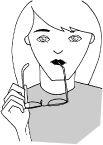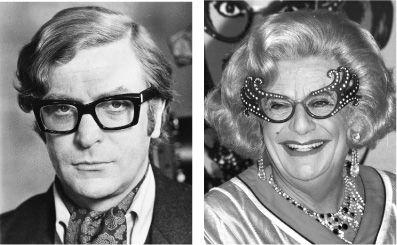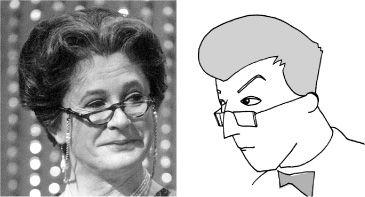The Definitive Book of Body Language (43 page)
Read The Definitive Book of Body Language Online
Authors: Barbara Pease,Allan Pease

In films, the leader of a motorcycle gang or criminal syndicate is usually portrayed as a tough, aggressive man who, as he smokes, tilts his head back sharply and with controlled precision blows the smoke toward the ceiling to demonstrate his superiority to the rest of the gang. In contrast, Humphrey Bogart was often cast as a gangster or tough guy who held his cigarette inverted in his hand and blew the smoke down from the corner of his mouth as he planned a jailbreak or other devious activity. There also appears to be a relationship between how positive or negative the person feels and the speed at which he exhales the smoke. The faster the smoke is blown upward, the more superior or confident; the faster it is blown down, the more negative he feels.
If a smoker is playing cards and is dealt a good hand, he is likely to blow the smoke upward, whereas a poor hand may cause him to blow it downward. While some card players use a “poker face” when playing cards as a way of not showing any
body signals that may give them away, other players like to be actors and use misleading body language to lull the other players into a false sense of security. If, for example, a poker player was dealt four of a kind and he wanted to bluff the other players, he could throw the cards facedown on the table in disgust, curse, cross his arms, and put on a nonverbal display indicating he'd been dealt a poor hand. But then he quietly sits back and draws on his cigarette and blows the smoke upward. And then he Steeples. It would be unwise for the other players to now bet on the next hand, as they would probably be beaten. Observation of smoking gestures in selling situations shows that when smokers are asked to buy, those who have already reached a positive decision blow the smoke upward, whereas those who have decided not to buy, blow downward.
The original study of smokers we carried out in 1978 showed that smokers took significantly longer to reach a decision in a negotiation than nonsmokers and that the smoking ritual is performed most often during the tense moments of the negotiations. Smokers, it seems, are able to stall decision-making by diverting their attention to the smoking process. So if you want quicker decisions from smokers, negotiate in a room that displays a large “No Smoking” sign.
Cigars have always been used as a means of displaying superiority because of their cost and size. The big-time business executive, the gang leader, and those in high-status positions are often portrayed as smoking cigars. Cigars are used to celebrate a victory or achievement such as the birth of a baby, a wedding, clinching a business deal, or winning the lottery. It is not surprising that most of the smoke exhaled by cigar smokers is blown upward. At a celebration dinner where cigars were distributed freely we noted that of 400 recorded cigar-smoke exhalations, 320 were in an upward direction.
Most smokers smoke their cigarette down to a certain length before extinguishing it in an ashtray. Women tend to slowly stub the cigarette out, while men are likely to crush it with the thumb. If the smoker lights a cigarette and suddenly extinguishes it earlier than he normally would, he has signaled his decision to terminate the conversation. Watching for this termination signal can allow you to take control or to close the conversation, making it appear that it was your idea to end things.
Almost every artificial aid a person uses gives them an opportunity to perform a number of revealing gestures and this is certainly the case with those who wear glasses. One of the most common gestures is placing one arm of the frame in the mouth.

Using the glasses to stall for time
As Desmond Morris pointed out, the act of putting objects against the lips or in the mouth is a momentary attempt by the person to relive the security he experienced as a baby at his mother's breast. This means that the Glasses-Arm-in-Mouth gesture is essentially a reassurance gesture.
If you wear glasses you may sometimes feel as if you are looking at life through two toilet-paper rolls, but you are perceived by others as being more studious and intelligent, particularly in the early stages of a meeting. In one study, people
pictured wearing glasses were judged by respondents as being fourteen IQ points more intelligent compared to when they were not wearing them. This effect lasted less than five minutes, however, so you would be wise to consider wearing them only for short interviews.
The “intelligent” look is reduced, however, if you wear glasses with oversized lenses, Elton John-style colored frames, or designer glasses with distracting initials on the frame. Wearing glasses that are one size larger than the face can make younger people look older, more studious, and more authoritative.

Solid frame glasses can make you look more sincere
and intelligent; over-the-top frames don't
In our study using pictures of people's faces, we found that when you add glasses to a face in a business context, respondents describe that person as studious, intelligent, conservative, educated, and sincere. The heavier the frame on the glasses the more frequently these descriptions were likely to be used and it made little difference whether the face was male or female. This could be because the leaders of business who wear glasses use heavier frames. So in a business environment, glasses are a statement of power. Frameless, small, or spindly frames convey a powerless image and say that you are more interested in fashion than business.
The reverse holds true in social contexts, but in these situations you are selling yourself as a friend or mate. We advise people in positions of power to wear stronger frames to make serious points, such as reading a financial budget, and frameless styles when conveying a “nice guy” image or being “one of the boys.”
As with cigarette smoking, the Glasses-Arm-in-Mouth action can be used to stall or delay a decision. In negotiating, it has been found that this gesture appears most frequently at the close when the person has been asked for a decision. Continually taking the glasses off and cleaning the lenses is another method used by glasses wearers to gain time for a decision. When this gesture is seen immediately after a decision has been asked for, silence is the best tactic.
The gestures that follow Glasses-Arm-in-Mouth signal the person's intention and allow an alert negotiator to respond accordingly. For example, if the person puts the glasses back on, this often means that he wants to “see” the facts again. Folding the glasses and putting them away signals an intention to terminate the conversation, and throwing the glasses onto the desk is symbolically rejecting the proposal.
Actors in films made during the 1920's and 1930's used Peering-Over-the-Glasses to portray, for example, a critical or judgmental person such as a teacher in an English public school. Often the person would be wearing reading glasses and find it more convenient to look over the tops, rather than removing them to look at the other person. But whoever is on the receiving end of this look may feel as though he is being judged or scrutinized. The habit of looking over the glasses can be a very costly mistake because the listener may respond to this look with negatives such as
folded arms, crossed legs, or an argumentative attitude. If you wear glasses, remove them when speaking and put them back on to listen. This not only relaxes the other person, but allows you to have control of the conversation. The listener quickly becomes conditioned that when you take your glasses off, you're taking the floor, and when you put them back on, it's his turn to talk.

Peering-Over-the-Glasses intimidates everyone
Contact lenses can make your pupils appear dilated and moist and can also reflect lights. This can give you a softer, more sensual appearance, which is fine for social contexts but can be disastrous in business, especially for women. A woman can find herself trying her best to persuade a businessman to buy her ideas, while he is mesmerized by the sensual effect of her contact lenses and doesn't hear a word she says.
Tinted glasses and sunglasses are never acceptable in business contexts and arouse suspicions in social environments. When you want to convey that you see things clearly and precisely you must have clear glass in the frames—keep sunglasses and tinted lenses for outdoors.
People who wear dark sunglasses during meetings are seen as suspicious, secretive, and insecure, while those who wear them
on their head are perceived to be relaxed, youthful, and “cool”—just back from Club Med, in fact. This is because they give the wearer the appearance that they have two huge eyes with dilated pupils on the top of their head; this mimics the nonthreatening effect that babies and cuddly toys with painted large pupils have on us.

Creating the “Four Eyes” effect of dilated pupils
Wearing makeup definitely adds to perceived credibility, especially for women in business. To demonstrate this we conducted a simple experiment. We hired four similar-looking female assistants to help sell our training products at a seminar. Each woman was given her own separate merchandise table and all were dressed in similar clothing. One assistant wore glasses and makeup, the second wore glasses and no makeup, the third had makeup and no glasses, and the fourth had neither makeup nor glasses. Customers would approach the table and talk with the assistants about the programs, spending an average discussion time of between four and six minutes. When the customers left the tables they were asked to recall information about each woman's personality and appearance and to choose adjectives from a list that best described each woman. The woman wearing both makeup and glasses was described as confident, intelligent, sophisticated, and the most outgoing. Some female customers saw her as confident but also cold, arrogant, and/or conceited—indicating they may have seen her as a possible competitor, because the men never saw her this way.
The assistant who wore makeup and no glasses received good ratings on appearance and personal presentation but lower on personal skills such as listening and building rapport.